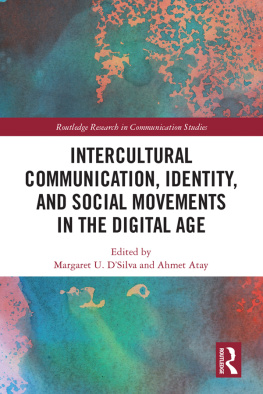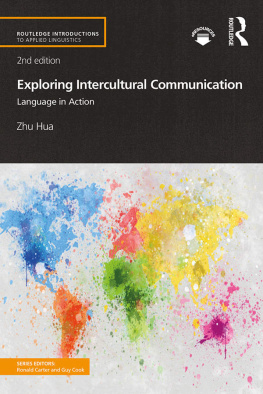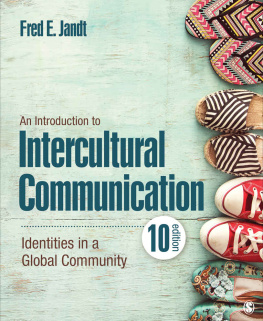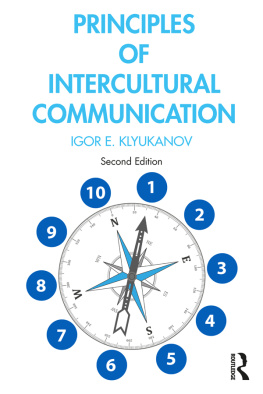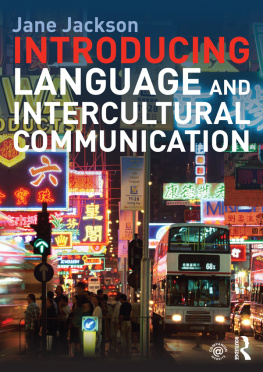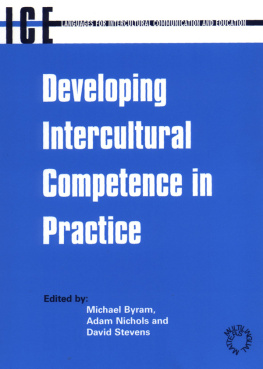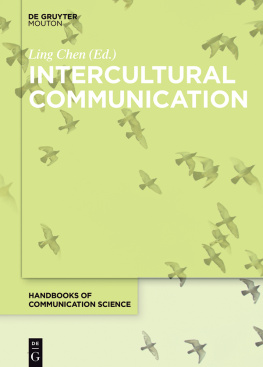


Copyright 2015 by SAGE Publications, Inc.
All rights reserved. No part of this book may be reproduced or utilized in any form or by any means, electronic or mechanical, including photocopying, recording, or by any information storage and retrieval system, without permission in writing from the publisher.
Printed in the United States of America
Library of Congress Cataloging-in-Publication Data
Neuliep, James William, 1957
Intercultural communication : a contextual approach / James W. Neuliep, St. Norbert College. 6th Edition.
pages cm
Includes bibliographical references and index.
ISBN 978-1-4522-5659-7 (pbk.)
1. Intercultural communication. 2. Culture. I. Title.
HM1211.N48 2014
303.482dc23 2013046952
This book is printed on acid-free paper.
14 15 16 17 18 10 9 8 7 6 5 4 3 2 1

FOR INFORMATION:
SAGE Publications, Inc.
2455 Teller Road
Thousand Oaks, California 91320
E-mail:
SAGE Publications Ltd.
1 Olivers Yard
55 City Road
London EC1Y 1SP
United Kingdom
SAGE Publications India Pvt. Ltd.
B 1/I 1 Mohan Cooperative Industrial Area
Mathura Road, New Delhi 110 044
India
SAGE Publications Asia-Pacific Pte. Ltd.
33 Pekin Street #02-01
Far East Square
Singapore 048763
Acquisitions Editor: Matthew Byrnie
Associate Editor: Nancy Loh
Assistant Editor: Katie Guarino
Editorial Assistant: Gabrielle Piccininni
Production Editor: Jane Haenel
Copy Editor: Megan Granger
Typesetter: C&M Digitals (P) Ltd.
Proofreader: Jen Grubba
Indexer: Terri Corry
Cover Designer: Scott Van Atta
Marketing Manager: Liz Thornton
Detailed Contents
Preface to the Sixth Edition
I ntercultural Communication: A Contextual Approach (sixth edition) is designed for undergraduate students taking their first course in intercultural communication. The purpose of the book is to introduce students to the fundamental topics, theories, concepts, and themes at the center of the study of intercultural communication.
The overall organizational scheme of the book is based on a contextual model of intercultural communication. The model is based on the idea that whenever people from different cultures come together and exchange verbal and nonverbal messages, they do so within a variety of contexts, including a cultural, microcultural, environmental, sociorelational, and perceptual context. The model is conceptually and graphically consistent and is presented in .
The overall organizational scheme of the sixth edition is consistent with the earlier editions, but many substantive revisions have been incorporated. Each chapter has been revised and updated to include the most recent research in the field. A continuing and exciting feature of this edition is Student Voices Across Cultures. Each chapter includes at least one essay from a student applying a concept from that chapter to his or her life experiences. Students from China, Saudi Arabia, the Faroe Islands, Mexico, Germany, Colombia, Sweden, and the United States have contributed to this feature. Many of the U.S. students discuss their study-abroad experiences. These essays provide the reader with real-life applications of theoretical concepts. The sixth edition includes five new Student Voices Across Cultures essays. The role of modern technology and its impact on intercultural communication has also been added to many chapters. A few chapters contain a new feature called Developing a Skill Set to help students apply what they have learned in the chapter.
, students can complete and score the Personal Report of Communication Apprehension, the Generalized Ethnocentrism Scale, and the Personal Report of Intercultural Communication Apprehension. The chapter closes with a delineation of five fundamental assumptions of intercultural communication. The Student Voices Across Cultures profile in this chapter presents one young womans experiences with cultural differences while studying abroad in Spain.
. Well-recognized topics such as individualismcollectivism, highlow context, weakstrong uncertainty avoidance, value orientations, and smalllarge power distance are discussed. Self-report scales measuring each of these topics are included in the chapter, and a new scale that measures vertical and horizontal individualism and collectivism has been added. Although most textbooks present individualism and collectivism as opposite dimensions of cultural variability, they are not mutually exclusive; that is, they can coexist within a person of any culture. However, there is an argument that both individualistic and collectivistic ideals serve the self, or are pancultural. The discussion of the pancultural self has been updated and extended. The section on Schwartzs value system also has been completely revised with additional and updated citations. Two Student Voices Across Cultures profiles are included in this chapter: one from a Chinese student who discusses collectivism in China and the other from a Saudi Arabian student who explains power distance in his family.
The focus of includes an updated discussion of five U.S. microcultures: Hispanics, African Americans, Amish, Hmong, and LGBT (lesbian, gay, bisexual, and transgender) groups. In this new edition, a sixth groupAsian Americansis also profiled. Included in this chapter is a Student Voices Across Cultures profile written by a gay college professor, who discusses personal examples of being silenced as a member of a microculture.
includes coverage of the nature of privacy in the United States, with a special focus on the perceptions of privacy among U.S. students. The section on online privacy has been revised, now including a summary of an interesting report issued by Privacy International. A new discussion of natural disasters as cultural and social events has been added as well, including a discussion of the 2011 tsunami in Japan. Although natural disasters are triggered by natural events (e.g., tsunamis, earthquakes, floods, etc.), the effects of such disasters vary considerably across cultures because they take place within particular social and cultural systems of laws and values. In the Student Voices Across Cultures profile included in this chapter, a young man from Germany discusses his countrys monochronic time orientation. A new chart summarizing characteristics of monochronic and polychronic time orientations also has been added.
is a discussion of American racism as a parallel to ethnocentrism. The geography of thoughtthat is, how geographical differences among cultures have a dramatic influence on how humans in those distinct geographical areas perceive the worldis discussed. Here, the focus is on how Asians (Eastern cultures) and Westerners think differently, and why. Another feature of this chapter is a fascinating discussion of the Stereotype Content Model, which explains how and why people stereotype and the essential content of those stereotypes. This model is applicable across cultures. A new feature of this chapter is a discussion of medias influence on stereotypes, including an application of Gerbners cultivation theory. The chapter applies cultivation theory to three microcultural groups in the United States, examining how they are depicted on television and the resulting stereotypes associated with them. Three specific groups studied are African Americans, Hispanics/Latinos, and Asian Americans. A new look at how Americans are stereotyped is also included here. In one of the Student Voices Across Cultures profiles in this chapter, a young woman who has won beauty pageants discusses the long-held stereotypes applied to beauty queens. In another profile, a student from the United States discusses being stereotyped while studying abroad in Ecuador.
Next page

